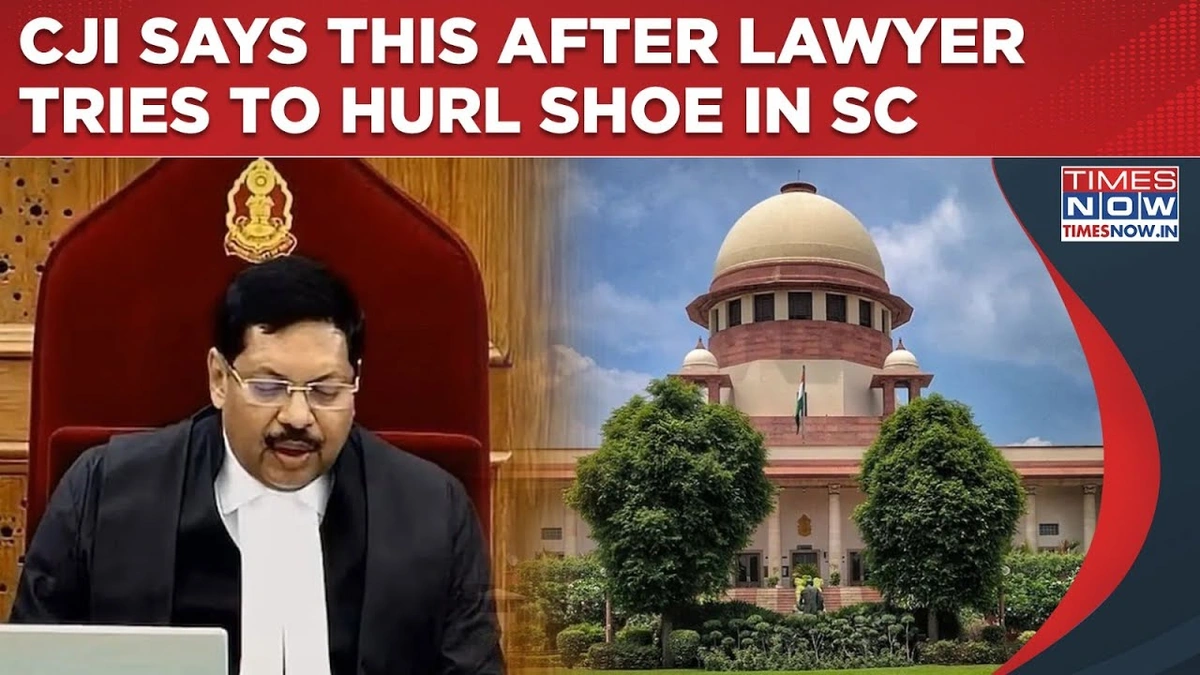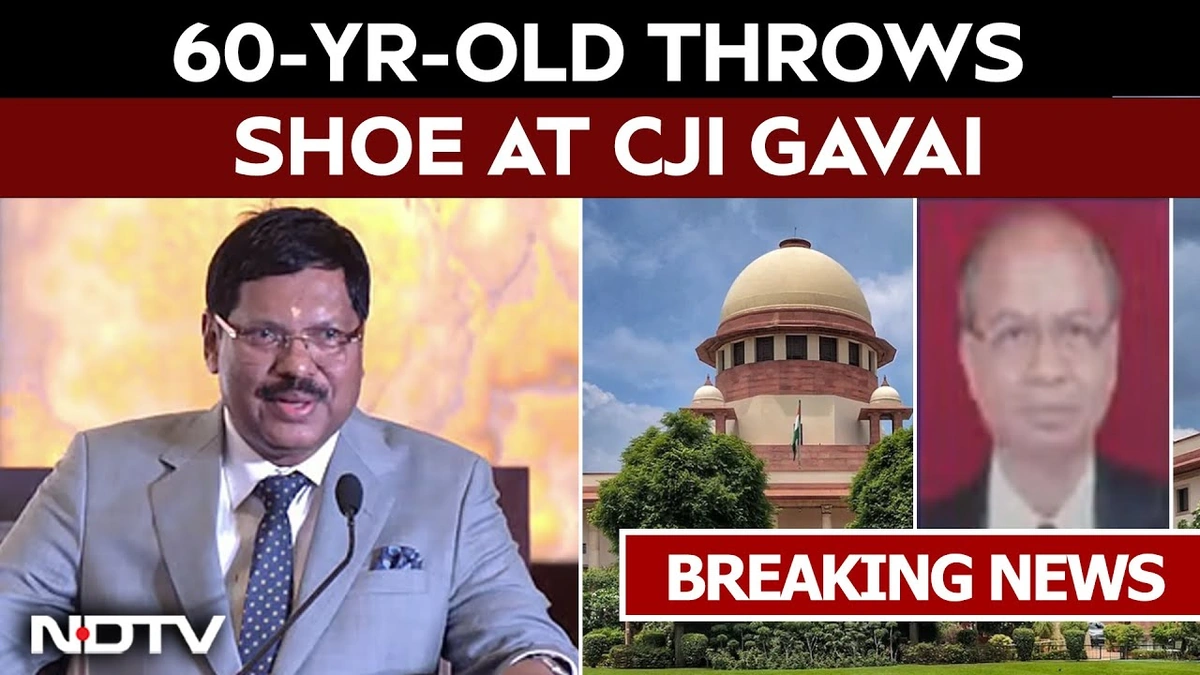Attorney Hurls Shoe at Chief Justice Gavai in Supreme Court, Protesting Sanatan Dharma Insult
Imagine the scene: the hallowed halls of the Supreme Court, the weight of the nation’s legal system pressing down. And then… a shoe. Yes, you read that right. An attorney, in a shocking display, allegedly threw a shoe at Chief Justice of India (CJI) DY Chandrachud ( though news reports say it was CJI Gavai) . The reason? Apparently, a protest against perceived insults to Sanatan Dharma. Let’s be honest, it sounds like something out of a movie – but it happened. Or, allegedly happened, depending on who you ask.
But this isn’t just about a shoe being thrown. This is about simmering tensions, the clash of ideologies, and the very public ways in which dissent is expressed in India. Forget the sensationalism for a moment; let’s delve into the “why” behind this bizarre incident. Why would someone resort to such an act? What does it say about the current socio-political climate? And, perhaps most importantly, what are the potential consequences?
The Sanatan Dharma Debate | Fueling the Fire

First, some context is needed. Sanatan Dharma, often considered synonymous with Hinduism, has been the subject of intense debate recently. Certain comments made by political figures have been interpreted as disparaging towards the religion, leading to widespread outrage amongst some segments of the population. Here’s the thing: in a country as diverse and religiously sensitive as India, even perceived slights can ignite powerful emotions. You have to remember, faith is not just a belief system here; it’s deeply intertwined with identity, culture, and community.
The attorney’s actions, however extreme, seem to stem from this very sense of grievance. By targeting the CJI, the individual arguably aimed to highlight what they perceive as a failure of the justice system to protect the sentiments of Sanatan Dharma followers. Now, I am not condoning the act. Violence or the threat of violence is never the answer. However, it’s crucial to understand the underlying motivations to truly grasp the significance of this event.
Understanding Contempt of Court
Throwing a shoe at anyone, let alone the Chief Justice of India, is a serious offense. Beyond the obvious charges of assault and disturbing court proceedings, the attorney could face contempt of court charges. Contempt of court, in essence, is any action that undermines the authority and dignity of the judiciary. It’s designed to protect the integrity of the legal process and ensure that courts can function without fear of intimidation or interference.
I initially thought the penalty would be small, but then I remembered the power of the courts. Penalties for contempt of court can range from fines to imprisonment. The severity of the punishment will depend on the court’s assessment of the intent behind the act and the degree to which it disrupted the administration of justice. The Supreme Court’s Authority is nothing to scoff at. The courts are meant to be respected and taken seriously.
Potential Ramifications for the Attorney
What are the immediate consequences for the attorney? Well, expect a whirlwind of legal proceedings. An investigation will be launched, charges will be filed, and the attorney will likely be suspended from practicing law pending the outcome of the case. But it doesn’t stop there. The Bar Council of India, the apex regulatory body for lawyers, could also initiate disciplinary action, potentially leading to disbarment. Basically, the attorney’s career is hanging by a thread.
And, let’s be honest, the reputational damage is immense. Regardless of the legal outcome, the attorney will forever be associated with this incident. It raises serious questions about their judgment and professionalism, making it incredibly difficult to rebuild their practice. Cuttack News reports similar instances of such acts happening over time.
Freedom of Speech vs. Disrespect of Court
Here’s where it gets tricky. Some might argue that the attorney was exercising their freedom of speech , using a dramatic gesture to express their dissent. However, the courts are likely to view this as a deliberate act of disrespect, exceeding the boundaries of acceptable protest. The right to free speech, while fundamental, is not absolute. It’s subject to reasonable restrictions, particularly when it comes to maintaining public order and the integrity of institutions.
The courts have been in place for centuries, and for good reason. It’s important to remember that the legal system is there to provide a framework for resolving disputes peacefully and fairly. It’s not a free-for-all where individuals can take the law into their own hands. Think about it: If everyone decided to express their grievances by throwing objects at authority figures, we’d descend into chaos pretty quickly.
The Bigger Picture | Dissent in a Democracy
So, what does this incident tell us about the state of democracy in India? It highlights the growing frustration and polarization within society. It suggests that some individuals feel unheard or ignored by the system, leading them to resort to increasingly desperate measures to voice their concerns. While this is not an excuse for unlawful behavior, it’s a wake-up call. A society that values dissent must provide avenues for constructive dialogue and redressal of grievances.
The key takeaway? This shoe-throwing incident is not just a bizarre news story. It’s a symptom of deeper issues within Indian society – a reflection of the tensions between tradition and modernity, faith and reason, freedom of speech and respect for institutions. What fascinates me is the fact that something as seemingly small as a shoe could trigger such a significant chain of events. Ultimately, it serves as a reminder that we must strive for a more tolerant and understanding society, one where differences are resolved through dialogue, not disruption. Hartalika Puja is another example of a clash in belief.
And, let’s not forget, it’s a reminder that even in the most serious of settings, the unexpected can happen. It’s a stark reminder that the human element – with all its passions and imperfections – is always present, even in the most formal of institutions.
FAQ
What exactly is Sanatan Dharma?
Sanatan Dharma is a term often used to refer to Hinduism, encompassing a wide range of philosophies, beliefs, and practices rooted in the Indian subcontinent.
What is contempt of court?
Contempt of court refers to actions that disrespect or undermine the authority and dignity of a court of law, hindering the administration of justice.
What are the potential consequences for the attorney?
The attorney could face charges of assault, disturbing court proceedings, and contempt of court, potentially leading to fines, imprisonment, suspension from practicing law, and disbarment.
Is freedom of speech absolute in India?
No, freedom of speech in India is subject to reasonable restrictions, particularly when it comes to maintaining public order, decency, and the integrity of institutions.
Where can I find reliable information about Indian law?
You can find official information on the websites of the Supreme Court of India ( https://main.sci.gov.in/ ), the Bar Council of India, and other government legal portals.
Was the Chief Justice Gavai Actually hit with a shoe?
According to several initial reports, it was said that Chief Justice Gavai was hit, but this has not been confirmed.













